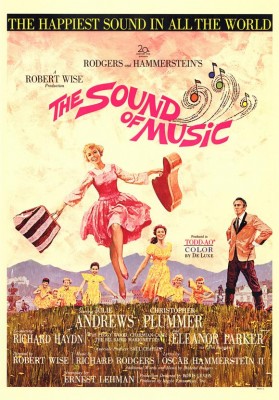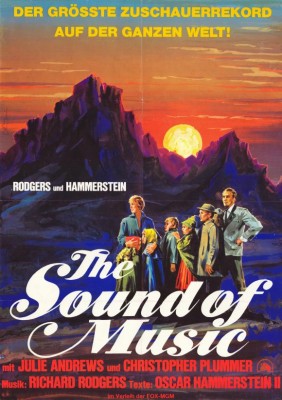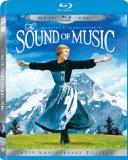| Reviews & Columns |
|
Reviews DVD TV on DVD Blu-ray 4K UHD International DVDs In Theaters Reviews by Studio Video Games Features Collector Series DVDs Easter Egg Database Interviews DVD Talk Radio Feature Articles Columns Anime Talk DVD Savant Horror DVDs The M.O.D. Squad Art House HD Talk Silent DVD
|
DVD Talk Forum |
|
|
| Resources |
|
DVD Price Search Customer Service #'s RCE Info Links |
|
Columns
|
|
|
Sound of Music, The
Let's face facts: The Sound of Music was a pretty lousy Broadway musical. Yes, the songs are pleasant enough if sugary, but the book was painfully contrived and as artificial as NutraSweet even though it's based on a true story. Relying on unbelievable dramatic conflicts, its leading man as written is a stiff, unappealing martinet (indeed quite the opposite of his real-life counterpart) that unrealistically turns into jelly halfway through. The kids are cute but almost never behave like real children and, on the stage, the play is static and lifeless. If the names Rodgers and Hammerstein hadn't been on the marquee, it seems likely The Sound of Music wouldn't have been nearly as successful as it was.
But, as it turned out, the show was the last collaboration of Richard Rodgers and Oscar Hammerstein II; the latter died nine months after its November 1959 Broadway opening. It premiered near the peak of their fame: Oklahoma!, Carousel, The King and I, and South Pacific had all recently been adapted into enormously successful roadshow movies, and a film of Flower Drum Song was in the works. Even a lesser effort like The Sound of Music was an all but guaranteed success.
The 1965 film, a lavish Todd-AO production produced and directed by Robert Wise, became the biggest film of its time, a genuine pop culture phenomenon, briefly eclipsing even the uneclipsible Gone with the Wind. (Adjusted for inflation, the film made $1,046,000,000, just behind Gone with the Wind and Star Wars. However, both of those films have been reissued more frequently than The Sound of Music.)
More importantly, while the book's weaknesses remain, Wise overcomes the musical play's static qualities, not only by opening it up and shooting most of it on location in Austria, but also by subtly telling its story visually, cinematically, much more so than previous Rodgers & Hammerstein movies, which weren't much more than filmed plays. Wise's visual storytelling is much underrated.
But the real draw is Julie Andrews, in what was only her third film (after Mary Poppins and The Americanization of Emily), the picture shot when her broad and lasting appeal was still uncertain. She's utterly captivating: a superb singer, youthful and uniquely attractive, and an excellent actress adept at both comedy and drama. She literally charmed her way around the movie-going world. Audiences adored her.
And because The Sound of Music was shot in Todd-AO, the best known of the various 65mm processes, Fox had higher-resolution film elements to work with, resulting in a superb high-def presentation for this Blu-ray release. Having seen it two or three times in its 70mm roadshow form, I can vouch that by far this release comes closest to emulating that viewing experience. In some respects it has less impact than recent Blu-rays of Chitty Chitty Bang Bang (filmed in Super Panavision 70) and White Christmas (filmed in VistaVision), but that's because Wise doesn't hesitate using soft focus, shallow depth-of-field and other cinematographic choices directors shooting large format films generally avoided.
The three-disc set (two Blu-ray discs and a standard-def DVD) recycles previously released extra features but adds a huge amount of new material, most of it incorporating technically clever if a bit unwieldy interactive functions.
The movie is very loosely based on the real-life Maria and Georg von Trapp (and their children) though the story of their romance, marriage and flight from Nazi-annexed Austria following the Anschluss Österreichs in 1938 compresses 10 years of events into about nine months, and many other events and particulars are altered for dramatic purposes.
In the film, Maria (Andrews) is a postulant at the Nonnberg Abbey, but not a very promising one. She's too talkative, direct, and easily distracted by the beauty of the Salzammergut foothills and, especially, her love of song. To test Maria's faith, the Mother Abbess (Peggy Wood) sends Maria to the large estate of Austrian naval hero and widower Capt. Georg von Trapp (Christopher Plummer), to spend the summer as governess of his seven children: Liesl (Charmian Carr), Friedrich (Nicholas Hammond), Louisa (Heather Menzies), Kurt (Duane Chase), Brigitta (Angela Cartwright), Marta (Debbie Turner), and Gretl (Kym Karath).
The children are unruly and mischevious, an apparantly passive-aggressive reaction to their emotionally-distant father, who since the death of his wife has strictly run the household like a ship under his command, even summoning the children via a complex series of coded whistles. However, a determined Maria soon wins the kids over and they come to love her. Though Georg becomes engaged with wealthy Baroness Elsa Schraeder (Eleanor Parker), he ends up falling in love with Maria instead, especially after she teaches the children to sing and thus reintroduce the sound of music into the cavernous but lonely von Trapp mansion.
The basic problems of the stage show, itself based on the first of two successful West German films, The Trapp Family (Die Trapp-Familie, 1956), and The Trapp Family in America (Die Trapp-Familie in Amerika, 1958)* are unfortunately retained in the 1965 film version. Maria's conflict between genuinely wanting to serve God as a nun and her love for her engaged employer is basically well done, though done better in Fred Zinnemann's The Nun's Story only a few years before. But the character of Capt. von Trapp is an unfortunate, unappetizing mess. He's supposedly never gotten over the death of his first wife but she's otherwise never mentioned by name and hardly at all after the von Trapp housekeeper (Norma Varden) briefly discusses this with Maria; there's not even a picture of her anywhere in the house. Her death made him cold toward the children, but why? Why does the children's singing transform him? What attracts him to the Baroness? Plummer, who admits in one of the documentaries that Capt. von Trapp was a pretty lousy role, doesn't show us any of von Trapp's pain in the first half of the film, only a kind of arrogant stiffness and, curiously, never particularly comes off as a warm and loving father in the second half, either. He's almost as aloof and awkward at the end of the picture as he was at the beginning.
Once Maria and Georg finally declare their mutual love, the dramatic conflict shifts to Georg's stout Austrian nationalism (meant to be admirable) vs. Third Reich fascism, and the von Trapp's efforts to flee the country. (In fact the real von Trapps simply left. By train. Fleeing to Switzerland from Salzburg over the mountains is geographically impossible.) There's little hint of Georg's antifascist views early on (the Baroness was a Nazi sympathizer in the original show, but this was dropped for the film) and complexities of the Anschluss, personified in the battle of ideologies between Georg and Nazi Hans Zeller (Ben Wright, later a frequent guest on Hogan's Heroes) is incredibly simplistic: Nazis = bad / loyal Austrians = good. The passive compliancy of Max Detweiler (Richard Hayden), Georg's longtime friend, who helps the von Trapps escape but who isn't above the occasional "Heil, Hitler" either, is dismissed.
The children are all cute and appealing, though at 22, Charmian Carr isn't at all a convincing "sixteen going on seventeen." The bigger problem is that the kids never talk like real children do: "I'm Brigitta, she's Louisa. She's thirteen years old, and you're smart! I'm ten, and I think your dress is the ugliest one I ever saw!" The dialogue spoken by the adults isn't much better, like this aside from the Baroness: "I really must speak to the cook about the Wiener schnitzel!"
And yet despite all this The Sound of Music is a pleasant, beautiful-looking film with Julie Andrews's enchanting performance at its center, winning the audience over just as she does Capt. von Trapp. Indeed, she's so key to the film's success - imagine if Mary Martin had reprised her Broadway characterization, or if Fox had hired an established star like Audrey Hepburn, Doris Day, or Debbie Reynolds - that in the few scenes not featuring her, a couple of minutes here and there between Plummer and Parker, the audience quickly becomes impatient, wanting to get back to Andrews and the children.
Some interiors were shot on Fox stages in what was then Beverly Hills (now Century City) but at least 60% of the film was made in and around picturesque Salzburg, ideally suited to 65mm lensing. Unlike most of the large format 70mm roadshows, Wise eschews the usual travelogue and audience participation effects associated with 70mm and Cinerama, although the opening mirrors almost exactly Wise's aerial prologue to West Side Story, urban jungle New York vs. the crisp Austrian mountains. Indeed, Wise uses myriad barely-perceptible cinematic devices to maximize scenes: the "bussing" effect (i.e., a shock effect credited to Val Lewton) bringing "My Favorite Things" to an abrupt end when Capt. von Trapp walks in on Maria and the children; long lenses during the first half of "Do-Re-Mi," flattening Maria and the children against the mountains; the good use of soft focus during the love scenes between Georg and Maria.
Video & Audio
The Sound of Music was filmed in Todd-AO, spherical 65mm format, with the aerial footage shot in a nearly identical process known as MCS-70. The results are extremely impressive: the blacks of the nuns' tunics, the ornate gold detailing on the walls in the von Trapp ballroom, the detail of the rain dribbling down the gazebo's glass walls, the silhouettes of Maria and Georg in the same gazebo later on. (Even the 20th Century-Fox logo looks staggeringly good.) Wise's use of soft-focus in those scenes creates an interesting effect in high-def; it's a softer image, but so detailed is its softness that it almost glows. The colors are incredibly rich and true; at times the Salzburg locations are so gorgeous that they almost don't look real.
The film runs 2:54:41. There's no overture or exit music, though there is an intermission cart and an entr'acte. The excellent audio includes a new 7.1 DTS-HD Master Audio mix that approximates original six-track magnetic stereo roadshow presentations, and a 4.0 Dolby Surround mix, presumably emulating the "CinemaScope Sound" of the general release version. Also included are a Spanish 5.1 Dolby Digital track and a 5.1 DTS French on, with optional subtitles in all three languages plus Portuguese, Danish, Dutch, Finnish, Norwegian, and Swedish. The second Blu-ray disc defaulted to Japanese subtitles on my Japanese PlayStation 3, but not Disc 1.
The two Blu-ray discs are region free and are accompanied by a Region 1 standard DVD of the film in 16:9 enhanced widescreen.
Extra Features
Disc One, with the feature in high-definition, is accompanied by an interactive group of supplements under the "Your Favorite Things" banner. An easy-to-understand series of menu screens guides the viewers to its four parts: 1) a picture-in-picture function heavy on stills and storyboards about the film's development and production; 2) a sing-along function with optional karaoke-style lyrics presented at the bottom of the screen; 3) a trivia track; 4) a quiz and movie locations feature. The viewer can turn all four functions on at once (plus the audio commentary tracks as well), but I found this multi-tasking needlessly overwhelming and after a 30-minute sampling had had more than enough.
Previously released audio commentaries are included, with Andrews, Plummer, and Wise.
Disc Two, also a Blu-ray, divides its supplements into five parts: "Musical Stages," in high-def, about 96-minutes worth of new supplementary material; and "A City in Song," also new and in high-def, basically a tour of Salzburg, with background on the various landmarks seen in the film. Each of these prompts the viewer to click on various topics relating to the original stage production, the real von Trapp family, origins of each of the songs, information about the picture and sound restorations, historical backgrounds of the various locations, etc. (Marni Nixon, Theodore Bikel, and members of the von Trapp family are among the on-camera interviewees.) Each segment runs about five minutes, and there's a wealth of good material throughout, such as Bikel's amusing anecdote about performing "Edelweiss" on Broadway.
Previously available material, from earlier DVD (and laserdisc?) releases, is entirely in standard-def and divided among "Vintage Programs," "Rare Treasures," and "Publicity" (including trailers that, alas, have not been bumped to high-definition).
Parting Thoughts
I have one of the earlier DVD releases of The Sound of Music but I never ended up watching it even once, mainly because I knew that even on the biggest widescreen TVs it could never really come close to replicating that 70mm roadshow look. This Blu-ray puts it one step closer, and a very rewarding viewing experience. A DVD Talk Collector Series title.
* Both ought to be released on DVD in the U.S. Fox reportedly owns the U.S. rights, so why not include it as an extra feature?
Stuart Galbraith IV's latest audio commentary, for AnimEigo's Musashi Miyamoto DVD boxed set, is on sale now.
|
| Popular Reviews |
| Sponsored Links |
|
|
| Sponsored Links |
|
|
| Release List | Reviews | Shop | Newsletter | Forum | DVD Giveaways | Blu-Ray | Advertise |
|
Copyright 2024 DVDTalk.com All Rights Reserved. Legal Info, Privacy Policy, Terms of Use,
Manage Preferences,
Your Privacy Choices | |||||||















